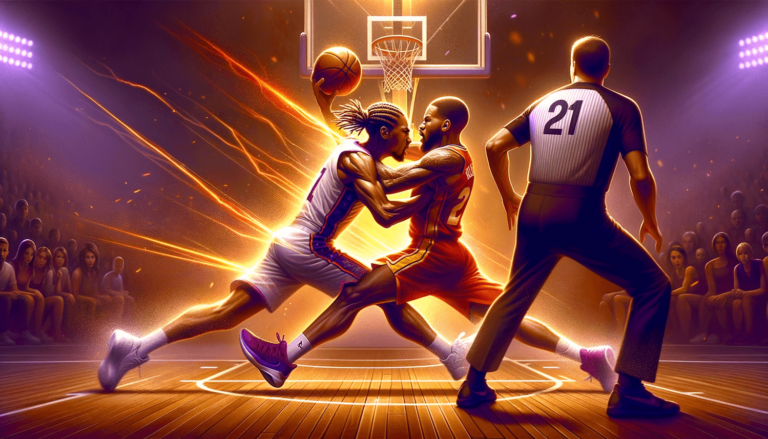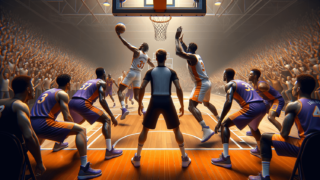
Flagrant 2 Foul Rule in Basketball
Written by: Basketball Universe
Last updated:

Welcome to an in-depth exploration of the infamous Flagrant 2 foul rule in basketball! This high-stakes violation has been the subject of numerous debates, rule changes, and even game-winning decisions. In the world of basketball, the Flagrant 2 foul brings together a brilliant concoction of athleticism, aggression, and, sometimes, a dash of controversy. Join us as we dive into this fascinating subject, unraveling its nuances and complexities that will satisfy your hunger for all things basketball-related. So, whether you’re a seasoned hoops fan or new to the game, buckle up, because we’re about to embark on an exhilarating journey through the captivating world of the Flagrant 2 foul!
Flagrant 2 Foul Rule in Basketball
The Flagrant 2 foul rule in basketball refers to a severe personal foul involving excessive or unnecessary contact with an opponent, often with the potential to cause injury. This type of foul is deemed unsportsmanlike conduct and warrants immediate ejection of the infringing player from the game, along with two free throws and possession of the ball awarded to the opposing team. The NBA’s Competition Committee reviews Flagrant 2 fouls after games to determine if additional penalties, such as fines or suspensions, are warranted.
Understanding the Ins and Outs of Flagrant 2 Foul Rule
Every basketball enthusiast knows that the rules of the game can be intricate, and foul calls are instrumental in shaping the outcome of a contest. One such regulation is the Flagrant 2 foul rule, which addresses unsportsmanlike conduct with severe consequences for players who engage in overly violent or dangerous behavior on the court. In this detailed look into the world of Flagrant 2 fouls, we’ll dissect the reasoning behind its creation, explain its impact on the game, and offer strategies for players—and fans—to avoid this costly mistake. Buckle up, it’s time to dive into the fascinating world of Flagrant 2 fouls and the basketball rules surrounding them.
The Birth of the Flagrant 2 Foul Rule
Before we delve into the specifics of the Flagrant 2 foul rule, it’s essential to understand its origin. The early days of basketball featured minimal rules and limited consequences for hard fouls. As the game evolved, so did its regulations — the NBA needed to protect its players from excessive violence on the court while maintaining competitiveness and excitement.
A response to increasing physicality
In the 1990s, the NBA witnessed a rise in overly aggressive play styles, with many teams adopting an extremely physical approach to the game. This increase in hard fouls culminated in several notorious on-court incidents, most notably the violence exhibited by the “Bad Boy” Detroit Pistons, which significantly impacted player safety. To deter these dangerous actions, the NBA decided that fouls deemed excessive and potentially injurious needed more severe punishments than regular personal fouls.
Introducing Flagrant Fouls
In response to these concerns, the NBA introduced the concept of flagrant fouls in the 1990-91 season to penalize beyond mere personal fouls. Flagrant fouls were divided into two categories — Flagrant 1 and Flagrant 2 — based on the severity of the infraction. The new rule was designed to curb unnecessary roughness on the court while still allowing for physical, competitive play.
Breaking Down the Flagrant 2 Foul Rule
Now that we’ve noted the impetus for the Flagrant 2 foul rule, let’s break down what constitutes such a violation, and its implications on the game.
Defining a Flagrant 2 Foul
A Flagrant 2 foul is deemed as any excessive or unnecessarily rough contact with an opponent that is not a legitimate basketball play. The key to identifying a Flagrant 2 foul largely lies in determining the offender’s intent, whether it was to commit an extreme act of unsportsmanlike conduct or cause injury. Examples include hard shoves, violent swings of the arms, dangerous takedowns, or an intentional blow to the head. Such plays have a higher likelihood of resulting in grievous injury and go beyond the boundaries of acceptable physicality in the sport.
Implications for the Player
The consequences of a Flagrant 2 foul are intentionally more punitive than other fouls in basketball. In addition to the standard two free throws awarded to the victim of the foul, a Flagrant 2 foul also results in the immediate ejection of the offender from the game. Furthermore, the NBA’s Competition Committee regularly reviews Flagrant 2 fouls to assess if additional penalties, such as fines or suspensions, are warranted. These strict measures ensure that players face severe consequences for their actions, promoting a safer playing environment for all.
Flagrant 2 Foul Controversies and Debates
With the strict punishments associated with Flagrant 2 fouls, the controversy is often inevitable. Officiating a Flagrant 2 foul can be highly subjective, as determining intent and severity is not a straightforward process.
Subjectivity in officiating
Game officials must make decisions regarding Flagrant 2 fouls in real-time, a daunting task given the speed and physicality of modern basketball. Differentiating between a hard-but-legitimate play and a Flagrant 2 foul is no easy feat, leading to subjective decisions that fans and players alike can heavily debate. To make matters more complicated, referees have the authority to upgrade a foul to a Flagrant 2 or downgrade it to a Flagrant 1 after a video review, further muddying the waters for fans trying to understand the finer nuances of flagrant foul classification.
Notable incidents
These controversial calls have led to many memorable incidents in NBA history. In the 2016 NBA Finals, for example, Draymond Green’s infamous groin kick on LeBron James was retroactively upgraded to a Flagrant 2 foul, resulting in Green’s suspension for a pivotal Game 5 and potentially altering the course of the championship series. As basketball continues to evolve, the debate surrounding the interpretation and application of the Flagrant 2 foul rule remains an ongoing conversation.
How to Avoid Flagrant 2 Fouls: Tips for Players
As a player, nobody wants to earn a Flagrant 2 foul due to the harsh implications on both a personal and team level. Here are some helpful tips to ensure you avoid these severe penalties while maintaining your competitive edge on the court:
Focus on fundamentals
Improving your technique and understanding of basketball’s rules will minimize the likelihood of a Flagrant 2 foul occurring. Solid defensive footwork and crisp offensive play can often be the difference between a clean game and a game marred by flagrant fouls. Being comfortable with physicality while also respecting the game’s fundamentals is the key to finding the right balance on the court.
Keep emotions in check
Rowdy atmospheres and high-pressure environments can sometimes push players beyond their limits. Maintaining an even keel and remaining composed throughout the game will reduce the chances of making dangerous or overly aggressive plays, which might result in a Flagrant 2 foul call. Remember that composure is key, both individually and for the team’s success.
Communicate with referees
Clear and respectful communication with game officials can go a long way in avoiding excessive physical play that could lead to unsavory infractions. Referees are essential to maintaining order on the court, and keeping an open dialogue with them will help players feel more informed about ongoing calls and potential foul situations.
What Flagrant 2 Fouls Can Teach Fans About the Game
While players are directly involved in Flagrant 2 fouls, these incidents also impart valuable lessons for basketball fans. Understanding the intricacies of the rule is not only a fascinating way to expand one’s knowledge of the game but also provides insights into team dynamics and the competitive spirit that underpins the sport.
Psychology in basketball
Flagrant 2 fouls may seem like isolated incidents, but they can also reveal the psychological aspect of basketball. High-stakes games and heated matchups can push players to their limits, showcasing the mental fortitude— or lack thereof—that athletes possess. Observing how teams and players respond to Flagrant 2 fouls says a lot about their ability to remain composed and focused on the ultimate goal: victory.
Strategic implications
A shrewd understanding of the Flagrant 2 foul rule can have significant strategic implications. Coaches often design game plans to exploit an opponent’s propensity for committing flagrant fouls, such as deploying aggressive defensive schemes or physical offensive players to get inside the heads of their adversaries. This savvy approach can lead to more opportunities at the free-throw line and, potentially, a compromised opposing roster due to foul trouble.
Wrapping It Up
Ultimately, the Flagrant 2 foul rule is a crucial aspect of modern basketball, serving to protect players from injury while still preserving the intense competitiveness that makes the sport beloved by millions. As we have explored the depths of this rule, its history, controversies, and impact on the game, the Flagrant 2 foul rule stands as a symbol of the ongoing balance between maintaining player safety and fostering the passionate spirit of basketball.
The Evolution of Flagrant 2 Fouls and its Enforcement
In the years since the inception of the Flagrant 2 foul rule, the enforcement and interpretation of it have evolved. The driving force behind this evolution has been the desire to deliver a more watchable, exciting, and safe basketball product. Understanding this evolution is key to grasping the significance of the rule as it is applied today.
Role of Video Review in Flagrant 2 Fouls
Upon the integration of video technology into the NBA officiating toolkit, referees now have an additional resource to help make accurate foul calls. Instant replay has emerged as a critical aspect of the game, especially when it comes to assessing Flagrant 2 fouls.
How video review has changed the game
Before the implementation of video review, referees had to rely on their real-time observations to assess the severity of a foul. In contrast, the availability of video review has enabled referees to analyze flagrant foul situations at multiple angles and slow-motion playback, resulting in more accurate assessments and consistent calls. This has also facilitated a more transparent process, as fans are now able to observe the same footage reviewed by referees, contributing to their understanding of Flagrant 2 foul enforcement.
Role of the NBA in Penalties and Discipline
The NBA plays an active role in determining additional penalties following Flagrant 2 fouls. By reviewing each incident, the league offices ensure consistency and fairness in the application of discipline. This process reinforces the seriousness with which the NBA views player safety and unsportsmanlike conduct in the game.
NBA Competition Committee
The NBA Competition Committee is responsible for reviewing all Flagrant 2 fouls to determine if additional penalties should be imposed. These penalties may include hefty fines or suspensions, which could have lasting implications for both the player and their team. The committee’s rigor in their evaluations underscores the league’s commitment to uphold the highest standards of player safety and conduct.
Consequences for the team
Beyond the ejection and possible suspension of the offending player, a Flagrant 2 foul can also have significant repercussions on the team. Funneling resources to cover fines, the potential loss of a key player due to suspension, and the shift in game strategies all contribute to the challenges faced by the team as a consequence of a Flagrant 2 foul. By understanding the wider impact of this rule on the entirety of a team, fans can better appreciate the importance of discipline and sportsmanship in basketball.
Flagrant 2 Foul Examples and their Aftermath
Throughout NBA history, there have been numerous high-profile Flagrant 2 fouls that serve as striking examples of the rule’s impact on the game. These incidents provide valuable insights into the interpretation and enforcement of the Flagrant 2 foul rule over time.
Lessons from past incidents
Some notable Flagrant 2 fouls in the past have garnered significant media attention and fueled heated debates. Cases such as Andrew Bynum’s takedown of J.J. Barea in the 2011 NBA playoffs or Metta World Peace’s (formerly known as Ron Artest) elbow attack on James Harden in the 2012 season left lasting impressions on the basketball world. Analyzing these incidents helps highlight the evolution of the game, the increasingly stringent enforcement of the Flagrant 2 foul rule, and the lessons that both players and fans can learn from these situations.
The consequences and controversies
The often-controversial nature of Flagrant 2 foul enforcement has provided numerous talking points for basketball enthusiasts, provoking intense discussions on fairness and consistency in the often-subjective world of officiating. Gaining a deeper understanding of the nuances and complexities of Flagrant 2 fouls equips fans with an enriched perspective, enabling them to engage in informed debates about contentious incidents and their potential implications on the outcome of games and even championship series.
Frequently Asked Questions
Despite our in-depth exploration of the Flagrant 2 foul rule, we understand that questions may still arise. To further enhance your understanding, we’ve compiled a list of frequently asked questions related to this fascinating aspect of basketball. Here are the top ten questions and their succinct answers:
1. What’s the difference between a Flagrant 1 and a Flagrant 2 foul?
A Flagrant 1 foul is unnecessary contact, while a Flagrant 2 foul is excessive and unnecessary contact with the potential to cause injury. Flagrant 2 fouls are considered more severe and carry harsher penalties, including player ejection from the game.
2. How does the team benefit after a Flagrant 2 foul has been called?
The opposing team is awarded two free throws, possession of the basketball, and the player who committed the Flagrant 2 foul is ejected from the game. Additionally, the NBA Competition Committee reviews the incident, which could result in further disciplinary actions like fines or suspensions.
3. What factors do referees consider when determining if a foul is a Flagrant 2?
Referees assess the severity of the contact, the offending player’s intent, and whether the action exceeds acceptable physicality in the game. They also review video footage to analyze the incident more accurately.
4. Can a player be ejected from the game when committing a Flagrant 1 foul?
No, a Flagrant 1 foul by itself does not warrant player ejection. However, if a player commits two Flagrant 1 fouls in a single game, they will be ejected as if they committed a Flagrant 2 foul.
5. Do Flagrant 2 fouls count towards a player’s season total for personal fouls?
Yes, Flagrant 2 fouls count as a personal foul, and they also count separately as flagrant fouls, which are monitored throughout the season due to their potential impact on suspensions and fines.
6. Can a regular foul be upgraded to a Flagrant 2 foul?
Yes, referees may review a regular foul through video review and upgrade it to a Flagrant 2 foul if they determine that the contact was excessive and unnecessary.
7. How do referees determine if a Flagrant 2 foul warrants additional disciplinary action?
Referees don’t have the authority to decide on extra disciplinary actions. Their role is to enforce the rules within the game, while the NBA Competition Committee is responsible for reviewing Flagrant 2 fouls and determining any additional penalties like fines or suspensions.
8. Can a Flagrant 2 foul be downgraded to a Flagrant 1 foul?
Yes, after examining video footage of the incident, referees may downgrade a Flagrant 2 foul to a Flagrant 1 foul if they conclude that the contact was unnecessary but not excessive enough for a Flagrant 2.
9. How common are Flagrant 2 fouls in the NBA?
Although they are not extremely common, Flagrant 2 fouls occur periodically throughout the NBA season. Their relative rarity underscores their severity and highlights the league’s commitment to player safety and disciplined gameplay.
10. Do Flagrant 2 fouls have any strategic implications in the game?
Strategically, Flagrant 2 fouls can affect game outcomes by removing key players from the court due to ejection, and they can also influence matchups, as teams may attempt to exploit an opponent’s propensity for committing such fouls. This awareness can lead to game-changing opportunities for coaches and players alike.
Featured Posts
- No pillar pages found.





